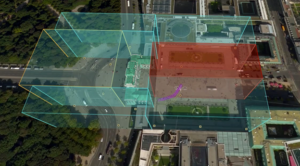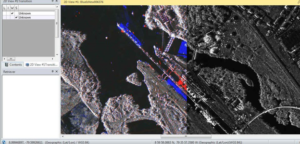Hexagon is no stranger to innovation, both with new inventions and with applying existing technologies to disrupt and improve existing or unexpected use cases. So we’re always keen on innovation by others and are supportive of their innovation agendas. An example is the newly formed NATO Defence Innovation Accelerator for the North Atlantic (DIANA), where the priority areas of focus will be:
- Energy resilience
- Secure information sharing
- Sensing and surveillance
DIANA will look at emerging and disruptive technologies (EDTs) from innovators and their applicability to NATO’s missions and operations. With Hexagon’s broad capabilities, cutting-edge technologies and trusted existing solutions, there are numerous possible applications in DIANA’s areas of focus.
Achieving energy resilience
Energy resilience means ensuring that energy is at all times available and sufficient to sustain NATO’s missions and operations. Technological solutions in this area should help allies better prepare for, minimize, adapt to and recover from both anticipated and unanticipated energy disruptions.
Network planners and engineers design complex networks for expanding, maintaining and securing power, telecommunications, water and other services. Due to their large geographic extents, often remote locations and minimal integrated defensive characteristics, they are a prime target for any adversary, whether to incapacitate or take control of the network. Life without electricity, gas or water is demoralising and causes diversion of efforts.
Benefits of network models
The apparently intentional damage of the Nord Stream pipelines, for example, shows a need for awareness of where networks are, whether above or below land or sea. It should also be easy to monitor the accessibility of the network and alert for any unexpected activity around the network.
Leveraging accurate network models can provide efficient solutions for collecting and integrating data as well as planning and designing multi-utility and communications networks. Increasingly, stakeholders in these industries rely on a wide range of data sources, including historic and real-time data.
Utilities and communications operations and service centres are responsible for overseeing the daily operations and maintenance of networks. To identify problems and prioritise, assign and execute field tasks, they rely heavily on real-time information and efficient tools for making informed decisions.
A suite of coordinated solutions that improve situational awareness about the state of the network is valuable. It can ensure service reliability, operational efficiency and customer satisfaction by rapidly connecting staff to relevant and reliable data and the necessary tools for resolving problems.
The ability to manage a network and rapidly reroute services, whether within cities and counties or between nations, is one that the HxGN Networks solution provides. It improves network planning, asset management and service reliability.
Preparing for cyber attacks
Attacks on a network may be not physical, but via the cyber realm. Assets must be secured via a holistic, enterprise-wide view of risk analytics. This is being standardised and led by the industrial control system (ICS)/operational technology (OT) security community for OT/ICS assets. PAS Cyber Integrity from Hexagon provides a holistic, enterprise-wide view of risk analytics.
Being able to plan and build renewable energy capacity, such as solar and wind, into a country’s network helps with resilience. These energy sources can also be used on tactical deployments, with transportable, rapidly deployed solar panels already available. It’s important to be able to visualize the site above and below ground and digitally map out every detail for the planning phase, including time, materials, estimating, scheduling and cost.
Data protection
Secure information sharing addresses the need for protected, reliable collection-through-dissemination of relevant data and ensures that the resultant data-derived information can be trusted.
Having a secure method for sharing data is good, but the data itself needs to be validated beforehand. This focus on the validation of data can include the truth and accuracy of the data values, the suitability of any subsequent analysis, the security of the data format(s), the quality and traceability of the data source and more.
There are then the simple aspects of data accuracy such as location (is it really an image of a building in Washington or London?) and time (was it captured at the time claimed?). Without validation within the data or against another data set, can the data be trusted?
Granular sharing
For onwards sharing of data, many security models work on a simple deny principle. There are options to share data by geographic area, by data subject level (share all rivers but not roads), by resolution in time and space (share only coarse data), by date (share only older data), etc. These security principles can be applied by assigning users roles and in different ways, such as data level, catalog level and web service level. Defence organisations use Hexagon’s technology to publish and distribute geospatial data and mapping.
Sensing and surveillance broadly applies to the detection and systematic observation of physical and digital domains, in order to enable, for example, situational awareness and forecasting.
With the acceptance and spread of deep learning and machine learning for use in sensing alerts, such as BLK247 edge processing, automated notifications are now a possibility. Whilst geographic bounds, or geofences, have been used along with a GNSS or location signal, that takes numerous data sources to create an alert. An example of this is zonal volumes for sensing intrusion of UAVs.
The sensors (collectors) used in ISR are being updated continuously, to identify new threats as well as for reduced costs. Being able to combine sensor data for use cases such as change detection can help spot an abnormality worthy of human operator examination. Just observing the pattern of life is not enough; spotting the anomalies within will often show the emerging threats. Working with synthetic aperture radar (SAR), an all-weather but difficult data type, and optical imagery, weather-dependent but easy-to-look-at data, in one platform can give an advantage.
With the digitalisation of defence underway, the automation of routines and workflows will help lessen the workload on human operators and increase the success rate of identifying potential threats. Capturing existing workflows and automating them helps deliver the correct information to the right decision maker at the right time. Hexagon’s Spatial Modeler is a no-code interface for achieving this.
The speed of data, information, communication and warfare itself represents both an opportunity and a threat. Digital superiority is critical to build flexible, effective and agile defence organisations and systems that are ready for all manner of confrontation or threat. Underpinning the ability to see what was (the past), what is (now), and what could and should happen as well as what will (predictions) will help NATO nations with the dimensions of location intelligence. Hexagon fast-tracks national defence strategies with future-proof technology solutions that provide allied nations with an enduring competitive advantage.



















